Many believe that planting grapes correctly and providing it with abundant top dressing and watering, you can get guaranteed harvest. But, alas, quite often it happens that an outbreak of an illness or an invasion of harmful insects in a matter of days destroys the results of many years of work. Therefore, in order to obtain stable full-fledged crops, it is necessary to constantly protect the vine from pests.
Content
Why is processing necessary?
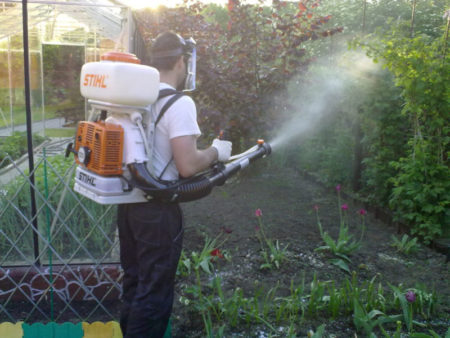 The main purpose of processing grapes is to prevent the emergence of diseases and the destruction of insect pests. Spring spraying of the diseased bushes during the winter period helps to prevent the further spread of the infection, and also destroys the causative agents of the disease. Also pollination with pesticides protects the vine from insects.
The main purpose of processing grapes is to prevent the emergence of diseases and the destruction of insect pests. Spring spraying of the diseased bushes during the winter period helps to prevent the further spread of the infection, and also destroys the causative agents of the disease. Also pollination with pesticides protects the vine from insects.
The main pests of grapes
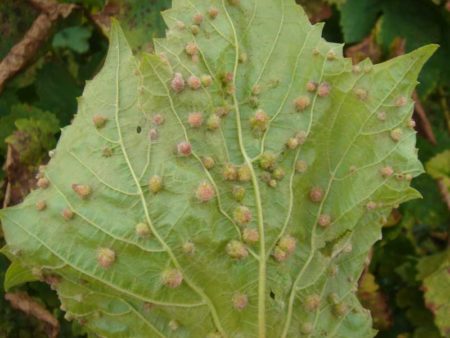 To determine which drug should be used for spraying, the gardener must be able to determine who specifically harms the plantings. The most dangerous insects:
To determine which drug should be used for spraying, the gardener must be able to determine who specifically harms the plantings. The most dangerous insects:
- phylloxera. Small aphids usually hide in the roots and lower part of the plant. Phylloxera larvae stick to the roots or trunk of the plant and drink juice. After the death of the plant, the larvae crawl to the next, thus gradually destroying the entire plantation;
- ticks. The tick family has very small sizes (from 0.15 to 0.6 mm). Ticks winter in grape buds, creep out into the light in spring at a temperature of 15-17 degrees. They feed on the kidneys and leaves of the plant, sometimes completely destroying it;
- leaflets. The family of leaflets is very numerous. Three types of grapes eat: grape leaflet, bunch leaflet and biennial leaflet. The voracious caterpillars of this harmful insect settle on the leaves of grapes and eat shoots, leaves, buds and flowers;
- willow woodworm. The caterpillars of this large (10 cm wingspan) butterfly feed on wood. Climbing to the center of the trunk, they can completely destroy the tree from the inside.
Processing time
For full protection, plantings are treated several times a year. An excellent effect is obtained with a combination of foliar top dressing and anti-insecticidal measures. Pollination of plants with drug solutions is carried out starting from the top, - so the sheet is better enveloped in liquid.
Spring processing
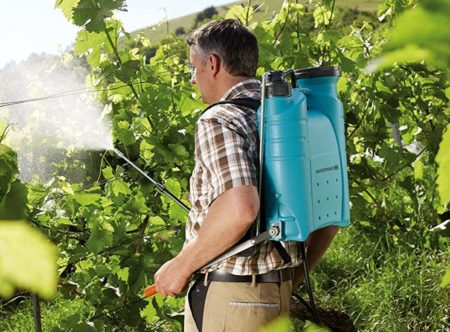 The first treatment is carried out immediately after raising the vines on the trellis. Usually this event is held when the air warms up above 5 degrees. To protect against diseases and rodents, the vine is sprayed with a 3% solution of copper sulfate. At the first spraying with the preparation, not only the trunk and branches are shed, but also the surrounding soil, so that the pathogenic microbes contained in the soil and mulch die.
The first treatment is carried out immediately after raising the vines on the trellis. Usually this event is held when the air warms up above 5 degrees. To protect against diseases and rodents, the vine is sprayed with a 3% solution of copper sulfate. At the first spraying with the preparation, not only the trunk and branches are shed, but also the surrounding soil, so that the pathogenic microbes contained in the soil and mulch die.
After half a month, in the phase of the appearance of the 5-6 first leaves of the plant, it is necessary to spray with nitrafen.
The last spring spraying is carried out before flowering.From downy mildew (mildew), copper-containing preparations are used; powdery mildew (oidium) - sulfur-containing; from ticks - drugs of the acaricidal group; for the prevention of fungal diseases, spray grapes with baking soda or iodine.
Summer processing
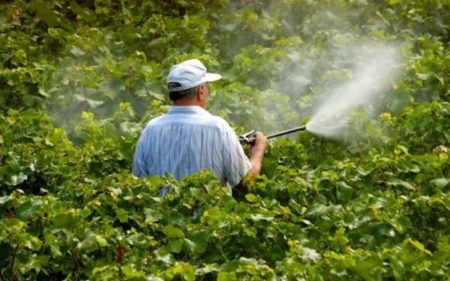 Summer treatment is carried out against fungal diseases. For this purpose, copper-containing, sulfur-containing preparations or a solution of potassium permanganate are used. Spraying begins during ripening, when the grapes grow to the size of a pea and spend every decade.
Summer treatment is carried out against fungal diseases. For this purpose, copper-containing, sulfur-containing preparations or a solution of potassium permanganate are used. Spraying begins during ripening, when the grapes grow to the size of a pea and spend every decade.
Autumn processing
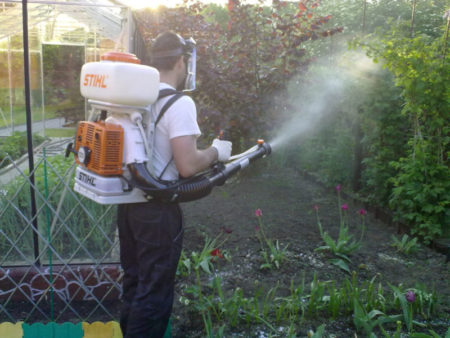 Grapes are processed in the fall immediately after pruning to prevent fungal diseases and damage to the bushes by rodents. For this purpose, in autumn, before shelter for the winter, it is necessary to spray grapes with copper sulfate. Spraying is carried out in the evening in cloudy, dry weather.
Grapes are processed in the fall immediately after pruning to prevent fungal diseases and damage to the bushes by rodents. For this purpose, in autumn, before shelter for the winter, it is necessary to spray grapes with copper sulfate. Spraying is carried out in the evening in cloudy, dry weather.
Vine Processing Tools
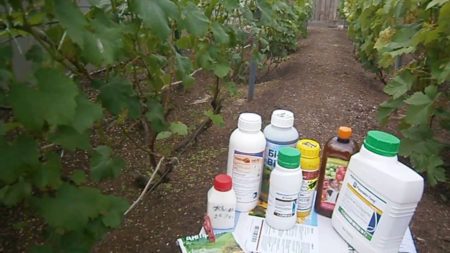 All preparations for the processing of vines can be divided into three large groups:
All preparations for the processing of vines can be divided into three large groups:
- chemical agents;
- biological agents;
- recipes from folk practice.
Chemicals
The industry produces many preparations for the processing of vines.
Bordeaux mixture
Bordeaux mixture copes with many fungal diseases. Apply it against gray rot, downy mildew and anthracnose.
The first time the vine is pollinated with a 3% solution of the mixture in early spring before the buds begin to bloom. The second time the drug can be used in the phase of active leaf growth, reducing the concentration of the solution to 1%.
inkstone
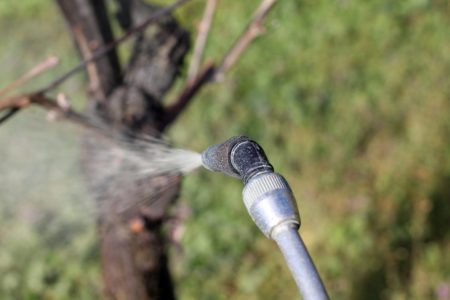 Spraying grapes with iron sulfate not only eliminates planting from fungal diseases, but also serves as a source of iron for plants. Apply a drug against powdery mildew, spotted necrosis, anthracnose and gray rot. Also, pollination of plantings in early spring pushes the buds to bloom, thereby protecting them from severe spring frosts. To do this, half a kilogram of iron sulfate is dissolved in ten liters of water. Plants are pollinated with a solution immediately after removing the winter shelter, later spraying leads to falling of color and scaring away pollinating insects.
Spraying grapes with iron sulfate not only eliminates planting from fungal diseases, but also serves as a source of iron for plants. Apply a drug against powdery mildew, spotted necrosis, anthracnose and gray rot. Also, pollination of plantings in early spring pushes the buds to bloom, thereby protecting them from severe spring frosts. To do this, half a kilogram of iron sulfate is dissolved in ten liters of water. Plants are pollinated with a solution immediately after removing the winter shelter, later spraying leads to falling of color and scaring away pollinating insects.
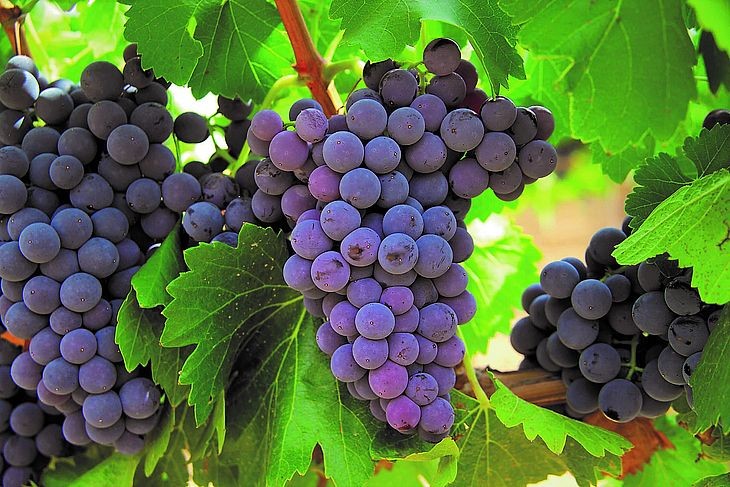 You may be interested in:
You may be interested in:Quadris
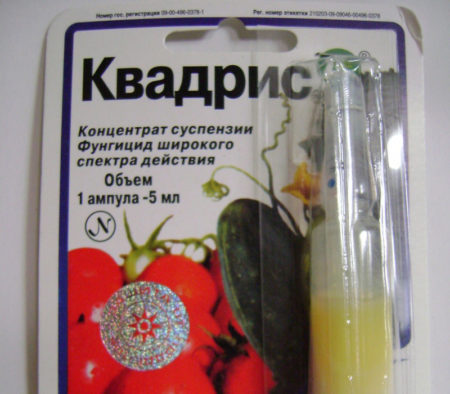 The drug Quadris perfectly helps in the fight against downy mildew, mildew and oidium. The fungicide has low toxicity and does not deter beneficial insects. The working concentration of the solution is 0.1%. Fungicide is especially effective when applied in the early stages of the disease, curing the disease in a day. The drug is compatible with all types of fertilizers and pesticides.
The drug Quadris perfectly helps in the fight against downy mildew, mildew and oidium. The fungicide has low toxicity and does not deter beneficial insects. The working concentration of the solution is 0.1%. Fungicide is especially effective when applied in the early stages of the disease, curing the disease in a day. The drug is compatible with all types of fertilizers and pesticides.
Blue vitriol
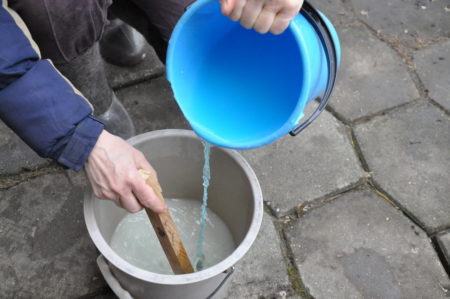
During preventive spraying, 100 grams of granules are poured into a bucket of water.
Urea
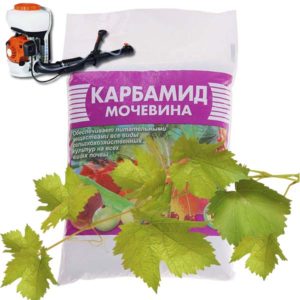 Nitrogen contained in urea (urea) is an excellent spring stimulator for the rapid growth of leaves and shoots of plants. At the same time, urea perfectly destroys colonies of coppers and caterpillars, and also protects plants from scab disease. For treatment and prevention, the vineyard is sprayed with a urea solution (0.5 - 0.7 kg of granules per 10 l of water) in the spring before the sap flow in the plants begins.
Nitrogen contained in urea (urea) is an excellent spring stimulator for the rapid growth of leaves and shoots of plants. At the same time, urea perfectly destroys colonies of coppers and caterpillars, and also protects plants from scab disease. For treatment and prevention, the vineyard is sprayed with a urea solution (0.5 - 0.7 kg of granules per 10 l of water) in the spring before the sap flow in the plants begins.
Reedomil
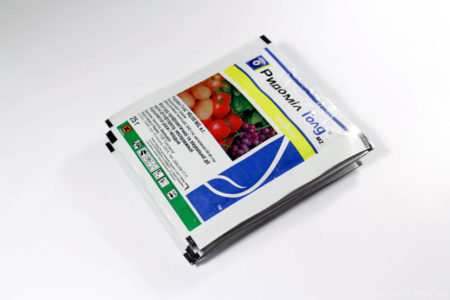 The drug Ridomil is used for the prevention and treatment of late blight, black rot, mildew, gray spotting and rubella. It consists of two active substances: mancozeb (640 g / kg) has a contact effect and, when it enters a plant, destroys the outer fungal colonies; menofix (40g / kg) penetrates the vine and protects it from the inside. The protective properties of the drug remain for two weeks even when rainy weather occurs.
The drug Ridomil is used for the prevention and treatment of late blight, black rot, mildew, gray spotting and rubella. It consists of two active substances: mancozeb (640 g / kg) has a contact effect and, when it enters a plant, destroys the outer fungal colonies; menofix (40g / kg) penetrates the vine and protects it from the inside. The protective properties of the drug remain for two weeks even when rainy weather occurs.
To prepare the solution for 1 bucket of water spend 25 grams of the drug. The first treatment is carried out at the stage of the appearance of the fourth leaf on the plant, then the process is repeated every two weeks. One to one and a half liters of solution is consumed per 10 square meters of landings.
Gates
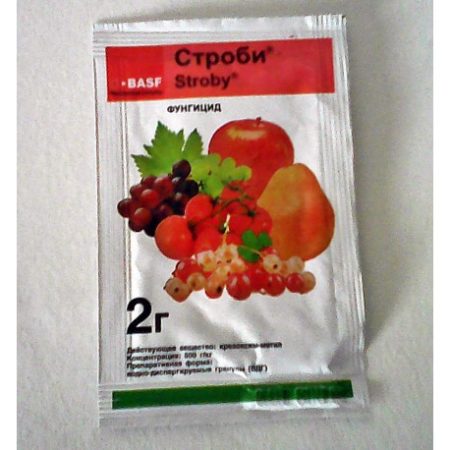 Strobi effectively fights against almost all fungal diseases. As part of the drug, the active substance kresoxime-methyl is used. Fungicide is available in granules packaged in packages of 2 or 200 grams. After applying the Strobi adheres to leaves and fruits, forming a protective film that destroys the spores of the mycelium. The drug is resistant to precipitation and therefore it is possible to work with it even in rainy weather.
Strobi effectively fights against almost all fungal diseases. As part of the drug, the active substance kresoxime-methyl is used. Fungicide is available in granules packaged in packages of 2 or 200 grams. After applying the Strobi adheres to leaves and fruits, forming a protective film that destroys the spores of the mycelium. The drug is resistant to precipitation and therefore it is possible to work with it even in rainy weather.
For spraying, 2 grams of Strob are bred in 10 liters of water. The first treatment of plants is carried out before flowering, then it is repeated every decade for preventive purposes. The last spraying is carried out a month before the harvest.
Falcon
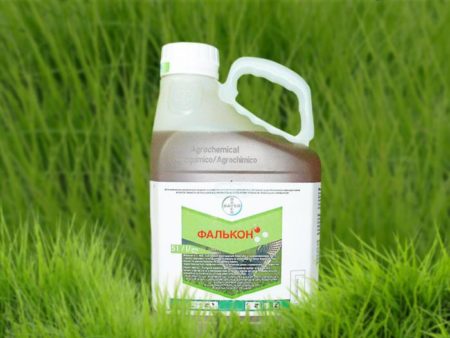 Fungicide Falcon perfectly copes with fungal diseases. The composition of the drug includes spiroxamine (250 g / l), tebuconazole (167 g / l) and triadimenol (43 g / l). The active components complement each other and complexly act on the mycelium, so the result is visible already two hours after spraying.
Fungicide Falcon perfectly copes with fungal diseases. The composition of the drug includes spiroxamine (250 g / l), tebuconazole (167 g / l) and triadimenol (43 g / l). The active components complement each other and complexly act on the mycelium, so the result is visible already two hours after spraying.
For prophylactic treatment, 5 ml of fungicide is diluted in ten liters of water. For treatment, the rate of introduced pesticide is doubled. To completely cure the disease, two pollination with fungicide is carried out, but a positive effect is achieved even after the first application.
Biological products
The basis of biological preparations is microorganisms, which are natural enemies of harmful insects or fungi affecting the vine. Biological agents can treat plants at any time during the growing season.
Fitosporin
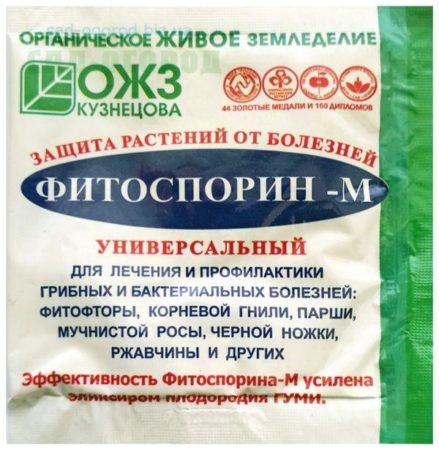 The drug is successfully used to combat late blight, root rot, powdery mildew and other fungal diseases. The basis of phytosporin is the artificially derived bacterium Bacillus subtilis. After entering the soil or plant tissue, the bacterium begins to multiply actively. The products of her life inhibit the development of fungal colonies, helping the plant to get rid of parasites on its own. The use of phytosporin strengthens the immunity of grapes.
The drug is successfully used to combat late blight, root rot, powdery mildew and other fungal diseases. The basis of phytosporin is the artificially derived bacterium Bacillus subtilis. After entering the soil or plant tissue, the bacterium begins to multiply actively. The products of her life inhibit the development of fungal colonies, helping the plant to get rid of parasites on its own. The use of phytosporin strengthens the immunity of grapes.
Phytosporin is marketed in the form of a paste, powder, or suspension. The consumption rate and method of application of the biological product depend on its packaging and concentration. For preventive purposes, pollination of the vines is carried out once every two weeks.
Trichodermin
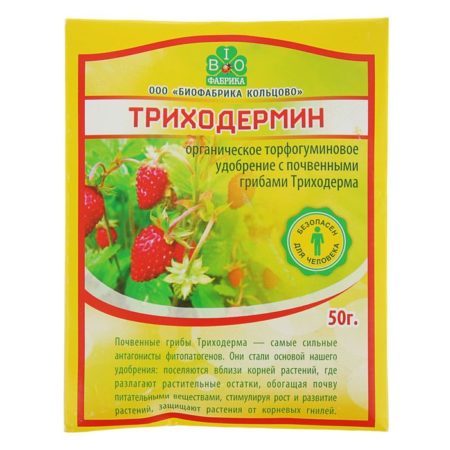 Trichodermin protects plants from gray rot, powdery mildew, anthracnose, root rot and other fungal diseases.The basis of trichodermin is the mushroom Tricoderma. When a beneficial fungus enters a plant, it begins to multiply actively, simultaneously destroying microorganisms harmful to the plant. To prepare the working solution, 50 ml of concentrate are taken per 1 bucket of water. For prophylactic purposes, pollination of vines is carried out from the beginning of leaf blooming every two to three weeks. Trichodermin is not toxic to humans, animals or insects.
Trichodermin protects plants from gray rot, powdery mildew, anthracnose, root rot and other fungal diseases.The basis of trichodermin is the mushroom Tricoderma. When a beneficial fungus enters a plant, it begins to multiply actively, simultaneously destroying microorganisms harmful to the plant. To prepare the working solution, 50 ml of concentrate are taken per 1 bucket of water. For prophylactic purposes, pollination of vines is carried out from the beginning of leaf blooming every two to three weeks. Trichodermin is not toxic to humans, animals or insects.
Actofit
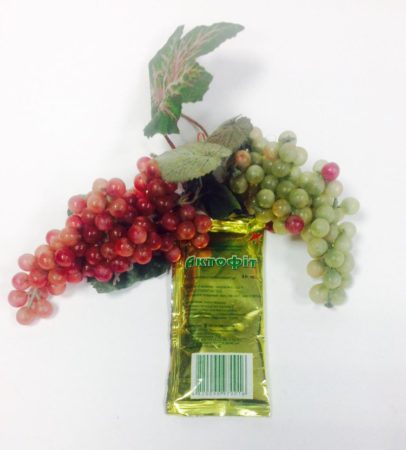 Actofit is designed to kill harmful insects. It is made on the basis of the vital products of the soil fungus Streptomyces avermitilis. Getting into the body of insects by contact or through food they eat, actophyte affects the nervous system, leading to paralysis of the digestive and respiratory organs. After use, the drug does not accumulate in the environment, but quickly disintegrates. Actofit is not toxic to birds, animals and humans. On sale, the drug is packaged in containers of 10, 40, 200 and 900 milliliters.
Actofit is designed to kill harmful insects. It is made on the basis of the vital products of the soil fungus Streptomyces avermitilis. Getting into the body of insects by contact or through food they eat, actophyte affects the nervous system, leading to paralysis of the digestive and respiratory organs. After use, the drug does not accumulate in the environment, but quickly disintegrates. Actofit is not toxic to birds, animals and humans. On sale, the drug is packaged in containers of 10, 40, 200 and 900 milliliters.
To process the vines, 20 ml of actophyte is diluted in three liters of water, thoroughly mixed, then another seven liters of water are added to the container. To enhance the treatment effect, ½ tsp is added to a bucket of water. baby shampoo Spraying is carried out as needed several times a season.
Colloidal sulfur
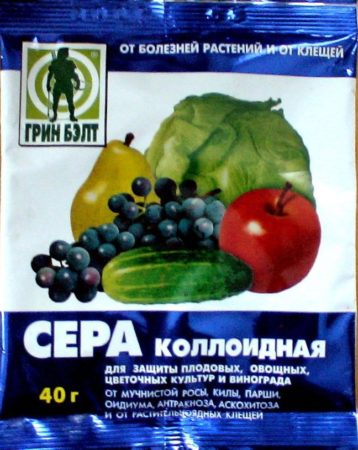 Colloidal sulfur has been used for many years to destroy spider mites, and also treats oidium and anthracosis. For processing 100 square meters. m vineyard 120 grams of sulfur is diluted in 100 grams of water to a homogeneous mass, then another liter of water is added to the resulting slurry and shaken until a suspension forms. The resulting solution is poured into 14 liters of water and stirred thoroughly. Processing of plantings is carried out 4-5 times per season.
Colloidal sulfur has been used for many years to destroy spider mites, and also treats oidium and anthracosis. For processing 100 square meters. m vineyard 120 grams of sulfur is diluted in 100 grams of water to a homogeneous mass, then another liter of water is added to the resulting slurry and shaken until a suspension forms. The resulting solution is poured into 14 liters of water and stirred thoroughly. Processing of plantings is carried out 4-5 times per season.
Folk remedies
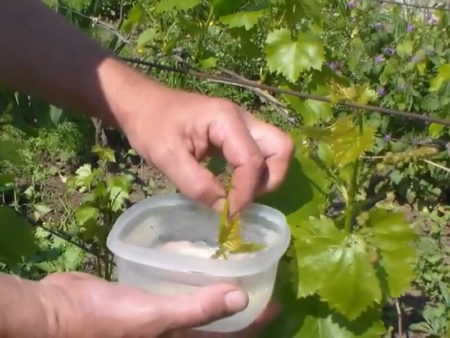 For many years of growing grapes, many folk remedies have been invented to protect the vines from diseases and pests. Many recipes will help to stop diseases and pests from the vineyard:
For many years of growing grapes, many folk remedies have been invented to protect the vines from diseases and pests. Many recipes will help to stop diseases and pests from the vineyard:
- from aphids will help pouring leaves with soap or ash solution. To do this, 300 g of soap or ash are bred in a bucket of water;
- parsley planted around the garden perimeter will protect the vine from phylloxera;
- harvest leaves will save a decoction of wormwood. Wormwood is boiled in water, then the cooled solution is filtered and used for pollination of leaves;
- from the odium. Soda ash is diluted in warm water at the rate of 40 g per bucket, a spoonful of liquid soap is added, everything is thoroughly mixed, and the affected plants are treated with this solution. It is also possible to use a soda solution for the prevention of diseases.
Disease prevention
By following a few simple rules, you can significantly reduce the risk of diseases:
- watering must be done exactly under the root of the plant, protecting the leaves from moisture;
- weeds under the bushes are removed, the soil is abundantly mulched with needles, thereby providing ventilation of the root zone of planting;
- Periodic pruning of plants contributes to good ventilation and lighting of bushes. The sun's rays do not allow pathogenic fungi to develop, and clipping leaves with brown spots prevents the spread of diseases;
- timely cleaning of fallen leaves helps get rid of spores of fungal diseases.
Conclusion
In order for the vine to please the owners with its bright healthy leaves and plentiful harvest, it is important not only to carry out the correct formation of the crown and top dressing, but also to spray it from pests and diseases in a timely manner. A carefully treated plant is practically not susceptible to dangerous diseases that can cause irreparable damage to the crop in a matter of days.


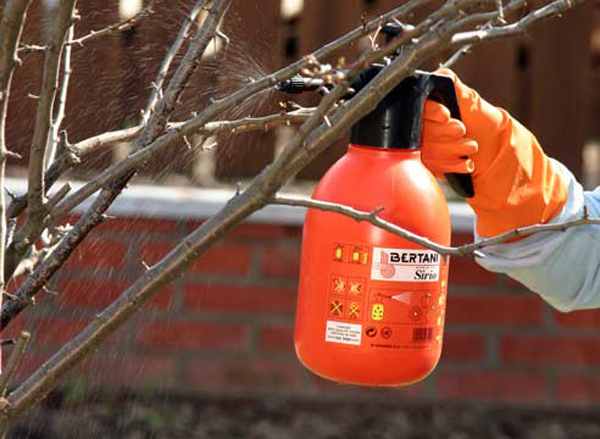



 Non-covering winter-hardy grape varieties for Moscow region
Non-covering winter-hardy grape varieties for Moscow region How to keep the vine in winter
How to keep the vine in winter When can I transfer grapes to another place in the fall
When can I transfer grapes to another place in the fall How to cover and prepare grapes for the winter in the suburbs
How to cover and prepare grapes for the winter in the suburbs